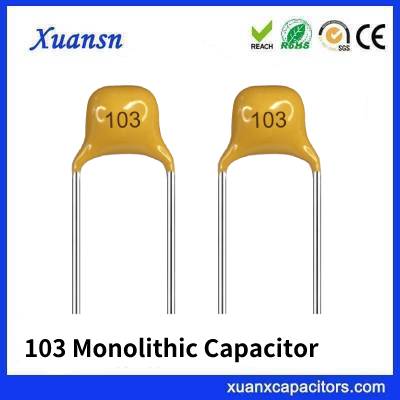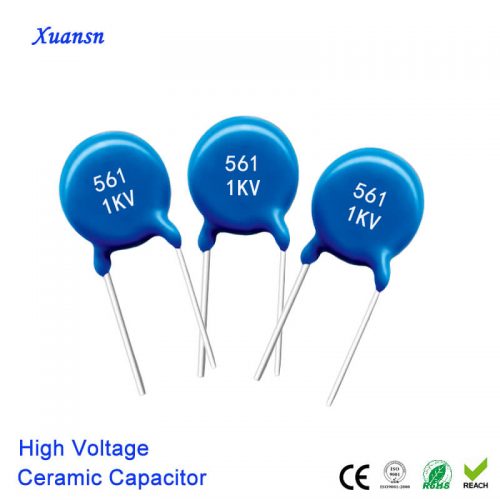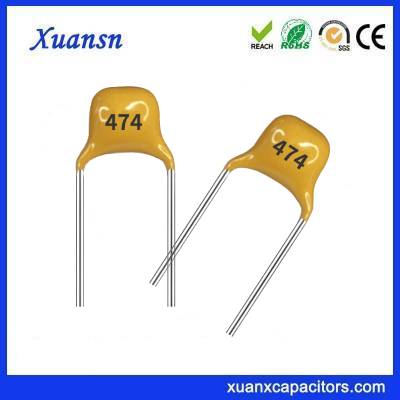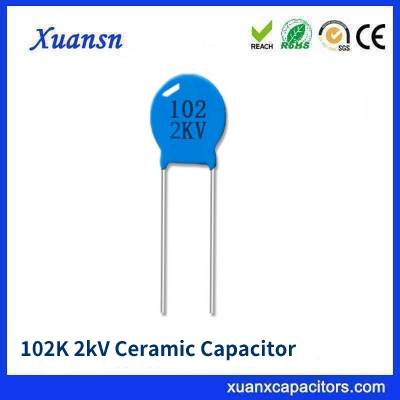- Compact size
- High capacitance values
- Low ESR
- Wide temperature range
- XUANSN Manufacturer
103 Monolithic Capacitor 50V 0.01UF Radial Ceramic bulk
Description
Product Page:
Definition:
The 103 monolithic capacitor is a type of electronic component widely used for energy storage and signal coupling in electrical circuits. It belongs to the family of monolithic capacitors and is specifically classified as a surface-mount device (SMD) with a capacitance value of 10,000 picofarads (pF), denoted by the code “103.”
Monolithic capacitors, also known as multilayer ceramic capacitors (MLCCs), are widely used in electronic precision instruments and small electronic devices for applications such as resonance, coupling, filtering, and bypass. They are characterized by their large capacitance, small size, high reliability, stable capacitance, high temperature resistance, good insulation, and low cost.
Monolithic capacitors, or MLCCs, can replace mica capacitors, paper capacitors, and even certain tantalum capacitors. They are particularly popular in small and ultra-small electronic devices like liquid crystal watches and micro instruments.
With advancements in reliability and integration of chip-capacity products, monolithic capacitors have found an expanded range of applications in various civilian electronic devices and equipment. They are commonly used in computers, telephones, program-controlled switches, sophisticated testing instruments, radar communications, and more.
Overall, monolithic capacitors, or MLCCs, are versatile components that offer significant advantages in terms of capacitance, size, reliability, and cost-effectiveness, making them a popular choice in the electronics industry.

Structure:
The 103 monolithic capacitor is constructed using a single ceramic layer with a conductive material, typically a metal, acting as the electrode. The ceramic material used is usually barium titanate or a similar dielectric material. The capacitor’s structure includes a protective coating to ensure durability and electrical insulation.
Characteristics:
- Capacitance: The 103 monolithic capacitor offers a capacitance value of 10,000 pF, making it suitable for various electronic applications.
- Voltage Rating: It typically has a voltage rating ranging from a few volts to several hundred volts, depending on the specific variant and manufacturer.
- Size: Monolithic capacitors are designed to be compact and space-efficient, allowing for high-density circuit designs.
- Low Inductance: They exhibit low inductance, enabling effective noise suppression and signal coupling in circuits.
- Temperature Stability: Monolithic capacitors demonstrate good stability over a wide temperature range, ensuring reliable performance in diverse environments.
Advantages:
- Compact Size: The 103 monolithic capacitor’s small form factor makes it ideal for miniaturized electronic devices and densely populated circuit boards.
- Low Inductance: Monolithic capacitors offer low inductance, making them effective in reducing electromagnetic interference and noise.
- High Reliability: These capacitors are known for their excellent long-term stability and reliability in various applications.
- Cost-Effective: Monolithic capacitors are generally more affordable compared to other types, making them a cost-effective choice for electronic designs.
Disadvantages:
- Limited Capacitance Range: Monolithic capacitors have a limited range of capacitance values available, which may restrict their use in certain applications requiring higher or lower capacitance.
- Capacitance Variations: There can be slight variations in capacitance due to factors such as temperature, voltage, and frequency. These variations should be considered in precision applications.
- Voltage Coefficient: Some monolithic capacitors may experience changes in capacitance with varying applied voltages, which can affect their performance in specific circuits.
Related Issues:
- Voltage derating: It is important to operate the 103 monolithic capacitor within its specified voltage rating to prevent electrical breakdown or premature failure.
- Frequency limitations: Monolithic capacitors have limitations in high-frequency applications due to their self-resonant frequency. It’s essential to consider their frequency response in circuit designs.
Conclusion:
The 103 monolithic capacitor, with a capacitance of 10,000 pF, is a versatile electronic component widely used for energy storage and signal coupling in electrical circuits. Its compact size, low inductance, and cost-effectiveness make it suitable for various applications. Although it has advantages such as high reliability and temperature stability, factors like limited capacitance range and voltage coefficient should be considered during circuit




